
INTRODUCTION
Apple trees are very, very common in Finland. It's been a real problem to find a good way to make full use of huge annual harvest of apples. So, why not try to make apple cider?
As I've always been interested in gastronomy and enjoy drinking good cider, I eventually started making my own cider. This is a page I set up to describe some of the procedures and share my experiences of cider making. Please share also your own experiences!
I've mainly been concentrating on the actual process of cider making. I suggest that you should study what issues should you be aware before trying to do your home brewing. Experience with fermentation with ex. home wines or beer helps a lot. In other words, I assume that you're familiar with the basics.
I usually tape my cider manufacturing process, so that I can see how I could learn and study. These pictures are of my 2002 batch of Åkero+Kaneli - apple varieties cider.
TYPES OF CIDER
I've been fermenting two types of cider. More or less traditional English cider and "commercial" type English cider. Finnish commercial ciders are sweet, light and filtered. Some taste like bear-gummies diluted in water. Even the best ones are usually some sort of strange hybrids made of apple wine. Nothing to strive for here! I do like English ciders best, but they're really expensive here in Finland. So I decided to make England my source in cider making.
You can also make great commercial type apple cider from normal apple juice made of concentrate (the usual cheap kind 100% apple juice found in every grocery store). You'll just have to make sure that there is no preservatives added. This includes C-vitamin, as all kinds of excessive amounts of antioxidant agents are keen to ruin the fermentation process.
CIDER MAKING PROCESS: The Apples & The Juice
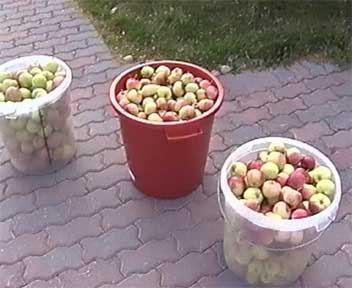
|
The apples.
The apples should be of highest quality with enough sugar and acid content overall. You can use all kinds of apple varieties, and I encourage you to try all kinds of different apples. For Finnish people, my personal favourite is kaneli. You can compensate for the lack of sugar and acidity in later steps. |
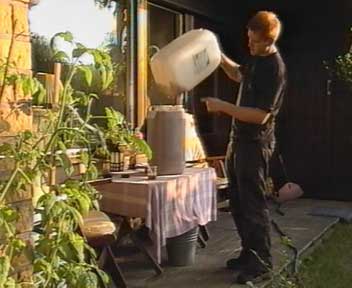 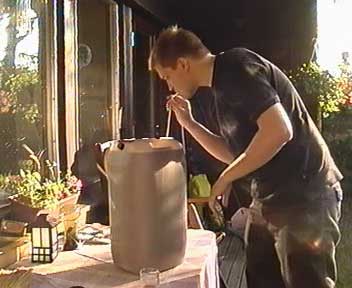
|
Extract the juice from the apples. It's important, that the juice as fresh as possible. Do not freeze it, or keep it in refrigerator. Taste the juice several times and make notes about the acidity and sugar content. If your juice is very acidous, you won't need to add any acid in the bottling phase. But It's usually safe to add some sugar (see starting the fermentation), even though you might have high sugar content. If your juice is strongly sedimentated, you might want to consider doing some kind of filtering. Traditional cider makers shun all kinds of clearing and filtering, but it's of no harm to filter the juice though for example a cloth. It only takes off the largest particles and in my opinion, enhances the result but is in no way a required step. You'll be needing 20-25 litres of juice. Now you can choose if you'd like to do traditional english cider or more commercial type. Both are very good choices. The difference is that traditional contains only juice and water is added to produce commercial type cider. Commercial type is clear and more gold coloured, traditional is a bit cloudy, strong tasting and dark. For commercial type cider, take about 20 litres of juice and add fresh water so that you'll get total of about 25 litres. |
CIDER MAKING PROCESS: The Fermentation

|
The additional ingredients.
You will be needing:
It's good to have large mugs, spoons and a large dipper for mixing. I'm using pectolase because it improves the final result. It removes pectine enzymatically and makes the juice more homogenous. (*) The cultured yeast isn't 100% necessary, but spontaneous fermentation is always a risky process. I really suggest that you use cultured yeast. Otherwise you could just ruin your juice. |
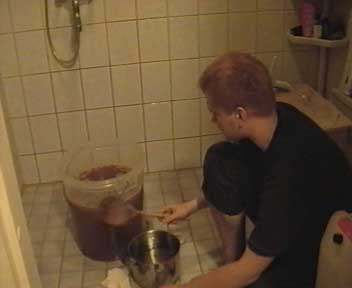
|
|
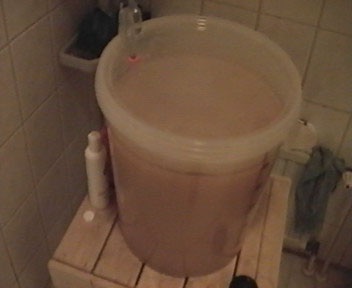
|
The fermentation.
Leave the cider to ferment. There is really no need to do anything but to make sure that the cider really starts to ferment. The length of the fermentation varies greatly, it can be anything from a few days to few weeks. The cider has been fermented completely when almost no bubbles come out from the airlock and it doesn't taste sweet (you can also use areometer). |
CIDER MAKING PROCESS: The Bottling, Secondary Fermentation and Maturing
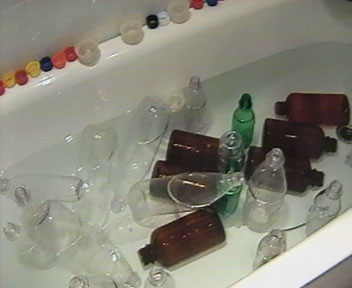
|
Washing the bottles.
I'm using old pharmacists bottles and ordinary 1,5L plastic soda bottles. Make sure all the bottles have very tight and working caps. You can also of course use standard 1/3L beer bottles, but it's not as well suited for long term storage. The cider will easily hold up to two years in the 1,5L soda bottles when kept in fridge temperature. Wash the bottles thoroughly with disinfectanting washing fluid. |
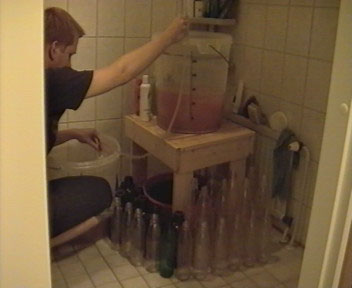
|
Bottling the cider and maturing.
Carefully syphon the cider to another vessel. Do not get greedy. Be extra careful not to get any sediment. You can consider leaving the syphoned cider to clear for a few days in a cool place. This is especially a good way, if you're doing commercial type cider. Then you should naturally syphon it once more. Mix the cider carefully, and taste it. Now is the time to do the acid compensation. I suggest that you use malic acid, if you can find it, but tartaric acid will do the trick too. I find it important that the cider isn't flat. It's very hard to give absolute amounts. Add to your taste, but be careful. Syphon the cider to bottles. Leave about 5cm of space to the bottle. Add about one tablespoon of sugar / 0.5L, seal the caps tightly and shake until the sugar has dissolved. If you'd like to have more apple taste to your cider, you might want to use some of the original apple juice (it can be preserved in the freezer or you can pasteurize it) in this step instead of adding plain sugar. I personally have found this a very good addition. Just add about 2L of juice to the vessel before bottling. You can also add the acid to the juice. Leave the bottles for 1-2 days into room temperature - usually one day is enough! Then you can move them to cool cellar or similar storage. It's very important that you don't keep the cider too long in the room temperature nor you mature it in too warm place. This may ruin your cider by excessive carbon dioxide production. After the first step of maturing you should store the bottles in a temperature of about 5C. You can monitor the amount of carbon dioxide by pressing the plastic bottles. Compare the feel to the one you felt just after the bottling. When the bottle feels a bit firm (not rock hard), you'll surely have enough carbon dioxide. It's better to be on the safe side, as you'll definitely ruin your cider, if it just showers like champagne! Always keep the bottles in upwards position and move them with extreme care. Be patient, wait at least for a month. Pour the cider carefully to a large jar so that the base sediment doesn't move. Enjoy your fresh batch of cider! Please, make sure that you tell me how it came out and share your experiences in the cider book!! Good luck! |